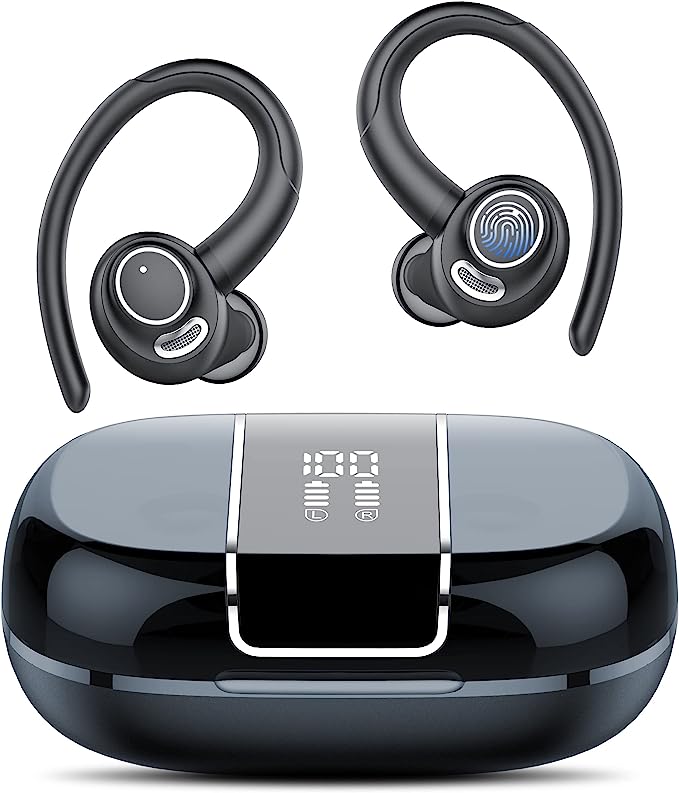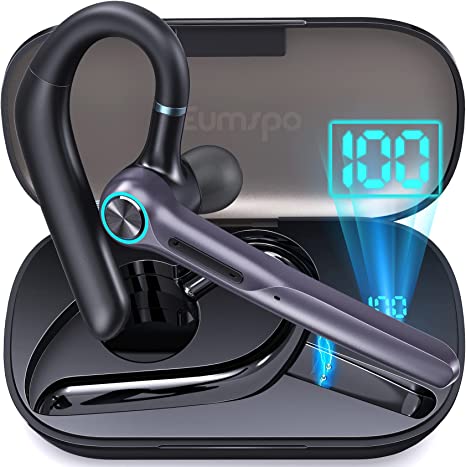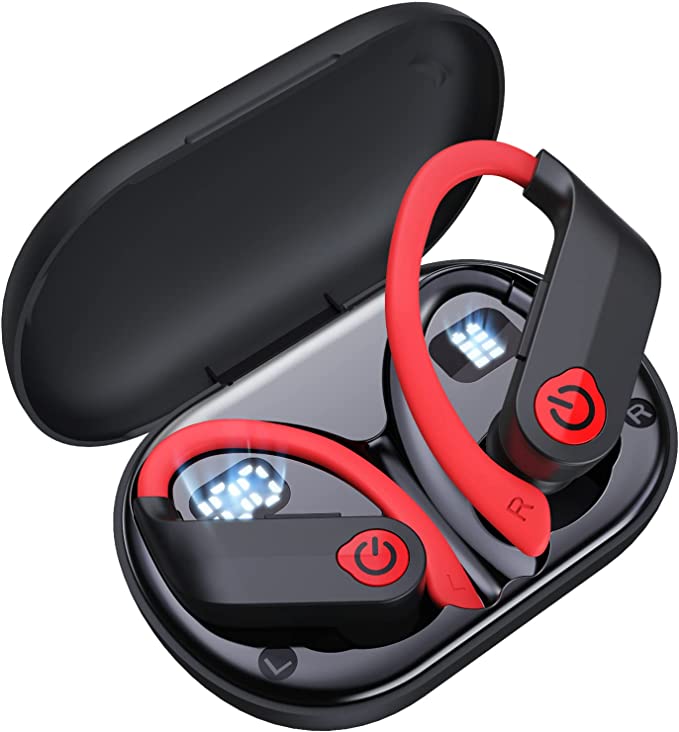We’ve all been there. You’re hitting your stride on a run, lost in the rhythm of your playlist, when suddenly – silence. Or worse, the dreaded fumble as an earbud, slick with sweat, makes a break for freedom towards the unforgiving pavement. For anyone who fuses their fitness routine with music or podcasts, the quest for the perfect audio companion is a familiar journey, often paved with frustration. We need gear that doesn’t just play sound, but understands and endures the demands of movement.
Enter the Csasan V90 wireless sport earbuds. On the surface, they present a list of features common in today’s market. But as an audio engineer, I’m always curious to look under the hood. How does the design actually tackle the challenges of an active lifestyle? What does “Bluetooth 5.3” or “IP7” really translate to when you’re pushing your limits? Let’s move beyond the marketing buzzwords and unpack the science and engineering principles that aim to make these earbuds a reliable ally for athletes and active individuals.

The Unshakeable Fit: Engineering Stability Against Motion
The first hurdle for any sport earbud is deceptively simple: staying put. Why is this so challenging? It boils down to physics. When you run, jump, or even turn your head quickly, you introduce forces – acceleration, deceleration, vibration. Add sweat into the mix, reducing friction, and a small, lightweight object nestled in your ear canal is easily dislodged. Traditional earbuds relying solely on an in-canal fit often lose this battle.
The Csasan V90 employs a fundamental ergonomic solution: the over-ear hook. Think of it less as just a piece of plastic and more as a carefully applied lever. This flexible hook rests gently but securely over the top ridge of your ear (the pinna). Doing so achieves two crucial things:
- Anchoring: It creates a primary anchor point, independent of the ear canal itself. This significantly counteracts the downward and outward forces generated during movement.
- Pressure Distribution: Instead of concentrating all the securing force inside the sensitive ear canal, the hook distributes some of the earbud’s minimal weight and securing pressure over a larger, less sensitive area of the outer ear.
This design borrows from basic biomechanics – understanding how the ear is shaped and how external forces interact with it. The goal isn’t just to prevent the earbuds from falling out, but to make them feel stable and secure while they’re in, reducing those distracting micro-adjustments mid-workout.
However, the hook is only part of the equation. A truly secure and comfortable fit also depends on a perfect seal within the ear canal. This is where the included three sizes (S, M, L) of soft silicone ear tips become critical. Finding the right size is deeply personal because, anatomically, no two ear canals are exactly alike. A proper seal accomplishes three things simultaneously:
* It maximizes physical stability, wedging the earbud comfortably but firmly.
* It enhances passive noise isolation, physically blocking a significant amount of external ambient sound, allowing you to focus on your audio without needing electronic noise cancellation for this aspect.
* It optimizes audio delivery, ensuring the sound produced by the driver is channeled directly towards your eardrum for the best possible sonic experience, especially in the bass frequencies.
Achieving this trifecta – stability from the hook, personalized seal from the tips – is the foundation upon which a good sport audio experience is built.

The Invisible Thread: Demystifying Bluetooth 5.3 and Seamless Pairing
Okay, so the earbuds are securely in place. Now, they need to reliably receive the audio signal from your phone or watch. This happens via Bluetooth, the ubiquitous short-range wireless technology that acts like an invisible thread connecting our devices. The V90 utilizes Bluetooth 5.3, one of the more recent iterations of this standard. But what does this version number actually mean for your workout soundtrack?
Think of the Bluetooth frequency spectrum (around 2.4 GHz) like a busy multi-lane highway shared by Wi-Fi routers, microwaves, other Bluetooth devices, and more. Older Bluetooth versions sometimes struggled with “traffic jams,” leading to annoying audio dropouts or stutters, especially in crowded environments like gyms. Bluetooth 5.3 introduces significant improvements, particularly:
- Enhanced Channel Classification: This is arguably the most impactful upgrade for connection stability. BT 5.3 devices are much smarter at identifying and predicting which “lanes” (frequency channels) are likely to become congested or suffer interference. They can more quickly and effectively hop to clearer channels, significantly reducing the chances of your music cutting out. It’s like having a Waze app for your Bluetooth signal, constantly finding the clearest path.
- Improved Power Efficiency: While not always dramatic, BT 5.3 includes refinements (like LE Power Control) that allow devices to operate more efficiently, potentially contributing to longer battery life for both the earbuds and the transmitting device (your phone). Every little bit helps when you’re aiming for endurance.
- Foundation for Future Features: BT 5.3 lays groundwork for features like Auracast broadcast audio and potentially lower latency in certain applications, although the specific benefits depend on support from both devices and the audio codecs used.
Essentially, Bluetooth 5.3 is about making that invisible thread stronger, more resilient to interference, and potentially more efficient. For the user, this translates to a more seamless, uninterrupted listening experience, letting you focus on your performance, not on fiddling with a spotty connection.
Adding a layer of convenience is the Hall Technology used for pairing. Inside the charging case, a tiny sensor detects the magnetic field change when the lid is opened. This instantly triggers the earbuds to power on and attempt to connect to the last paired device. It’s a small but elegant touch based on the Hall effect (the production of a voltage difference across an electrical conductor, transverse to an electric current and a magnetic field perpendicular to the current), eliminating the need to manually power on the earbuds each time.

Soundscapes & Clear Conversations: Drivers, Codecs, and Talking Through the Noise
A secure fit and stable connection are crucial, but ultimately, earbuds are about sound. Inside each V90 earbud sits a 13mm dynamic driver. Let’s break that down. The “driver” is the miniature speaker responsible for creating sound. “Dynamic” means it works much like a traditional loudspeaker: an electrical current passes through a voice coil attached to a diaphragm (a thin membrane), creating a magnetic field that interacts with a fixed magnet, causing the diaphragm to vibrate rapidly. These vibrations create pressure waves in the air – the sound waves that travel down your ear canal.
The “13mm” refers to the diameter of this diaphragm. Generally speaking, a larger diaphragm has the potential to move more air, which can translate to a greater capacity for producing lower frequencies (bass) and potentially a fuller overall sound. However, driver size is just one factor; the driver’s materials, enclosure design, and digital tuning play equally important roles in the final sound signature. So, while 13mm is relatively large for an earbud driver and suggests good bass potential, it doesn’t automatically guarantee audiophile quality – the overall tuning is key.

The audio data itself gets to the earbuds via SBC or AAC audio codecs. Think of codecs as digital languages used to compress audio data for efficient wireless transmission and then decompress it at the receiving end. SBC (Subband Codec) is the mandatory, universal Bluetooth codec – compatible with everything, but generally considered the baseline for quality. AAC (Advanced Audio Coding) is a more advanced codec, offering potentially better sound quality at similar bitrates, and is particularly well-optimized for Apple devices, though widely supported by Android too. The V90 supporting both ensures broad compatibility and decent audio quality across different devices.
Now, let’s talk about calls. The V90 features CVC 8.0 Call Noise Reduction. This is a point that often causes confusion, so let’s be crystal clear: CVC (Clear Voice Capture) is NOT Active Noise Cancellation (ANC) for your listening experience. ANC uses microphones to pick up ambient noise around you and generates inverse sound waves to cancel it out before it reaches your ears, creating a quieter listening environment.
CVC 8.0 works differently. It focuses entirely on the microphone performance during phone calls. It uses algorithms and the built-in microphone(s) to analyze the soundscape, differentiate your voice from background noise (like wind, traffic, or gym chatter), and then suppress that unwanted noise from the signal being sent to the person you’re talking to. It’s like having a noise filter specifically for your outgoing voice. The goal isn’t to make the world quieter for you, but to make your voice sound clearer and more intelligible to the person on the other end of the line, even if you’re in a noisy environment.

Braving the Elements: What IP7 Waterproofing Truly Means (and Doesn’t)
Active use means sweat. It often means unpredictable weather. Earbuds designed for sports need to be resilient. The V90 carries an IP7 waterproof rating. This “IP” stands for Ingress Protection, and the two digits that follow rate the device’s resistance to solids (first digit, often ‘X’ if not tested or specified) and liquids (second digit).
So, what does the ‘7’ in IPX7 signify? According to the international standard (IEC 60529), a device rated IPX7 must be able to withstand temporary immersion in fresh water up to 1 meter deep for up to 30 minutes without harmful ingress of water.
Let’s translate this lab-tested standard into real-world meaning for the Csasan V90:
* Sweat-Proof: Yes, they are designed to handle heavy perspiration during intense workouts.
* Rain-Resistant: Running in the rain should pose no problem.
* Splash-Proof: Accidental splashes from a water bottle or puddle are covered.
* Rinsible (Carefully): You could likely rinse them gently under tap water (cool, fresh water) to clean off sweat, though manufacturers usually advise caution.
However, it’s equally important to understand the limitations of IPX7:
* Not for Swimming: The rating doesn’t cover prolonged immersion or the pressure involved in swimming strokes. Bluetooth signals also don’t travel well underwater.
* Fresh Water Only: The tests are done in clean, fresh water. Saltwater, chlorinated pool water, soapy water, or other liquids can be corrosive or affect the seals differently.
* Not Steam-Proof: Avoid wearing them in saunas or steam rooms.
* Charging Port: The charging case is typically not waterproof, and the earbuds must be completely dry before being placed back in the case for charging to prevent damage.
The IP7 rating provides significant peace of mind for most athletic endeavors, ensuring your earbuds can survive the typical moisture exposure encountered during workouts and outdoor activities.

Endurance Champions: Powering Through Workouts and Beyond
Few things deflate motivation faster than the low-battery beep mid-session. Battery life is paramount for wireless earbuds, especially for those used during long workouts or throughout busy days. The V90 tackles this with impressive endurance figures.
The earbuds themselves claim up to 8 hours of playback on a single full charge. This is a solid duration, enough for even the longest marathon training runs or multiple shorter gym sessions. But the real star is the total playtime of up to 48 hours, achieved thanks to the 400mAh charging case. Think of the case as a portable power bank specifically for your earbuds. It holds enough charge to refuel the earbuds approximately 4-5 additional times before the case itself needs recharging.
Putting 48 hours into perspective: for someone working out an hour a day, 5 days a week, and commuting 30 minutes each way, that total playtime could potentially last well over a week without needing to find a wall outlet for the case. This freedom from constant charging anxiety is a significant quality-of-life improvement.
Keeping track of this power reserve is made simple by the LED digital display integrated into the charging case. It provides a clear percentage readout of the case’s remaining battery level, eliminating the guesswork often associated with simple indicator dots. You know exactly when it’s time to top up the case.
When that time comes, refueling is handled via USB-C, the modern, reversible connector standard that’s mercifully replacing older micro-USB ports. Not only is it easier to plug in (no more fumbling to get the orientation right), but USB-C generally supports faster charging speeds. The V90 case reportedly recharges fully in a respectable 1.5 hours.

Effortless Command: Navigating Your Audio with a Touch
Fumbling with tiny buttons on an earbud while running or wearing gloves can be awkward. The Csasan V90 opts for Smart Touch Controls. These rely on capacitive sensing, much like your smartphone screen. Your fingertip carries a small electrical charge, and touching the designated surface on the earbud changes the capacitance at that point, registering as a command.
This allows for intuitive, gesture-based control directly on the earbud surface. Common functions typically include:
* Single tap: Play/Pause music, Answer/End call
* Double tap: Skip track forward (often on right earbud), Previous track (often on left)
* Triple tap (sometimes): Activate voice assistant (Siri, Google Assistant)
* Press and hold: Adjust volume up/down (often right/left), Reject call
The specific mapping might vary, but the principle is to provide quick access to essential controls without needing to reach for your phone. This is particularly valuable during exercise when your hands might be busy or sweaty. Activating your phone’s voice assistant via the earbuds also allows for hands-free operation for tasks like sending messages, setting timers, or checking the weather while on the move.
Finally, broad compatibility with Bluetooth-enabled devices like iOS and Android smartphones, tablets, and smartwatches ensures these earbuds can seamlessly integrate into most users’ existing tech ecosystems.

Conclusion: Where Engineering Meets Experience
Dissecting the Csasan V90 reveals more than just a list of specifications. It showcases how specific engineering choices aim to solve the real-world challenges faced by active individuals seeking reliable audio. The ergonomic earhooks tackle the physics of staying put during motion. Bluetooth 5.3 strengthens the wireless lifeline against interference. CVC 8.0 focuses on clearer communication amidst noise. The IP7 rating offers resilience against the elements. And the extended battery life paired with convenient charging and controls provides the freedom and endurance needed for demanding routines.

Ultimately, the goal of technology like this isn’t just about the tech itself. It’s about enabling experiences. It’s about that uninterrupted flow state during a workout, fueled by music. It’s about easily taking an important call while jogging in the park. It’s about the convenience of gear that lasts as long as you do. From an engineer’s perspective, there’s a quiet satisfaction in seeing how principles of physics, electronics, and material science can be thoughtfully combined to create something that seamlessly integrates into and enhances the activities people are passionate about. The Csasan V90 earbuds represent one such effort to bridge the gap between technical capability and lived experience.




